12 gifts of nature
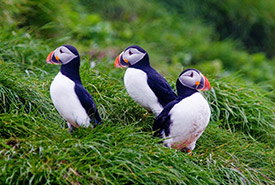
Atlantic puffins (Photo by Bill Caulfeild-Browne)
Every year, the holidays rush by. Anticipation builds, the festive spirit fills the air, holiday jingles loop on. For some, the rush to fill stockings and pick out the perfect gift is both challenging and stressful, but it doesn’t have to be. This year, I'm taking a minimalist approach and cuddle up with my daughters to watch documentaries about animals that I know they'll love, and hope they'll find nature awe-inspiring. You, too, can help spread some holiday cheer to some of our furry friends.
The Nature Conservancy of Canada’s popular Gifts of Canadian Nature initiative offers symbolic gifts, e-cards and eco-friendly paperless gifts to share with your loved ones.
Learn about some of the species you can symbolically adopt with a Gift of Canadian Nature by singing along to our rendition of "12 Days of Christmas", below:
On the first day of Christmas my true love gave to me…
An Atlantic puffin swimming in the sea
These iconic diving birds spend most of their life at sea. In winter, they shed their vibrant plumage and their beak turns drab and darker after breeding season. They become temporarily flightless at the end of the season until spring arrives and new feathers replace the old ones. Did you know that a puffin can hold up to 61 fish in its beak?
Two snowy owls camouflaging
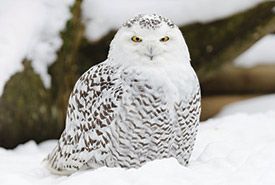
Snowy owl (Photo by ThinkStock)
An enduring symbol of Canada’s North, snowy owls are one of the heaviest owls in North America. You won’t usually find them hooting from trees. When overwintering in southern Canada, snowy owls prefer prairies and open fields similar to their tundra habitat, often camouflaging with the snow. Adult male owls are usually pure white in colour, while females are darker with feathers barred with dark brown.
Three bald eagles fishing
North America’s largest bird of prey also builds the largest nest of all birds on the continent. A bald eagle’s sharp eyesight (they can see three to four times further than humans) helps them spot prey, including fish, waterfowl and mammals, with precision. Did you know that if a bald eagle loses a feather on one wing, it will shed a feather on the other wing in order to keep its balance?
Four western bluebirds singing
These cheery blue- and rust-coloured songbirds can be found in parts of BC and Alberta. The coastal population in BC had disappeared by 1995, but there have been ongoing efforts to bring it back. You can help western bluebirds by setting up nest boxes.
Five wolverines prowling
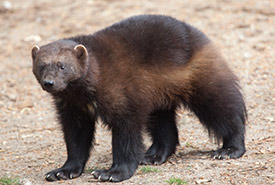
Wolverine (Photo by Dreamstime)
The Latin name for wolverines, Gulo gulo, means “glutton,” which describes the species’ voracious appetite, as it eats almost anything that crosses its path. They also have another name — skunk bear — thanks to their habit of marking food and landmarks with their musk. Despite their fearsome reputation, wolverines are shy and wary of humans.
Six plains bison roaming
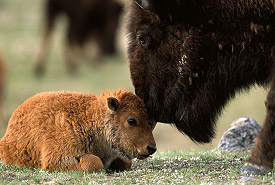
Plains bison calves, Old Man on His Back, SK (Photo by Don Getty)
These big, woolly-headed ruminants are agile beasts, running at speeds of up to 60 kilometres per hour and turning faster than a horse. Up to 60 million plains bison once roamed the continent in the 1800s, but have decreased to just a handful of animals at the turn of the century. At the Nature Conservancy of Canada’s Old Man on His Back Prairie and Heritage Conservation Area, a herd of 100 genetically pure plains bison graze the Prairies.
Seven monarchs flying
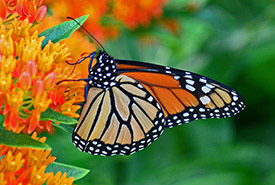
Monarch butterfly (Photo by Dave Nelson)
Monarch butterflies are one of the only insects that embark on a multi-generational migration of thousands of kilometres, to and from wintering grounds. To make this long journey, they ride along rising hot columns of air to conserve energy.
Eight grizzlies sleeping
Grizzlies are North America’s second largest bears, the first being polar bears. Contrary to popular belief, grizzly bears are not true hibernators. Their body temperature and breathing drops only slightly in winter, when they may become lethargic and sleep for long periods.
Nine swift foxes prancing
Small but mighty, swift foxes are about the size of a house cat and smaller than their red, Arctic and gray fox relatives. They can weigh up to three kilograms and run at speeds of up to 60 kilometres per hour. They live in short- to mixed-grass prairies, which provide them with a clear view of approaching predators. These canines are nocturnal and use their dens year-round, and can be found on NCC properties in Alberta and Saskatchewan.
Ten lynxes leaping
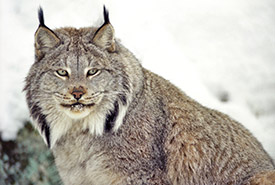
Canada lynx (Photo by Shutterstock)
Another secretive carnivore, Canada lynxes roam in intact forests. They resemble large domestic cats and have long tufts of hair on the tip of their ears and large, snowshoe-like padded paws to tread through deep snow. Their prey is almost exclusively snowshoe hares.
Eleven otters sliding
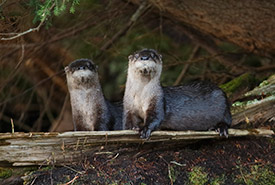
River otters (Photo by Dreamstime)
River otters are known for their playful behaviour and can be seen socializing in groups in aquatic habitats and riparian (riverbank) areas. Their powerful tail, which accounts for 40 per cent of their body length, can propel them through the water at 13 kilometres per hour, and at diving depths of up to 11 metres. River otters can hold their breath underwater for eight minutes.
Twelve moose bellowing
A full-grown male moose (bull) can measure two metres tall at the shoulder and weigh 600 kilograms. Males and females bellow out to each other in the fall during mating season. Although moose have extremely poor eye sight, they have a keen sense of smell and hearing. They can swim for several kilometres at a time and may dive up to five metres deep to find food.
Along with animal species, how about wrapping up a piece of endangered habitat as a Gift of Canadian Nature and a welcome change from the same old holiday gifts? Learn about the different ways you can support Canadian habitat and species here.


